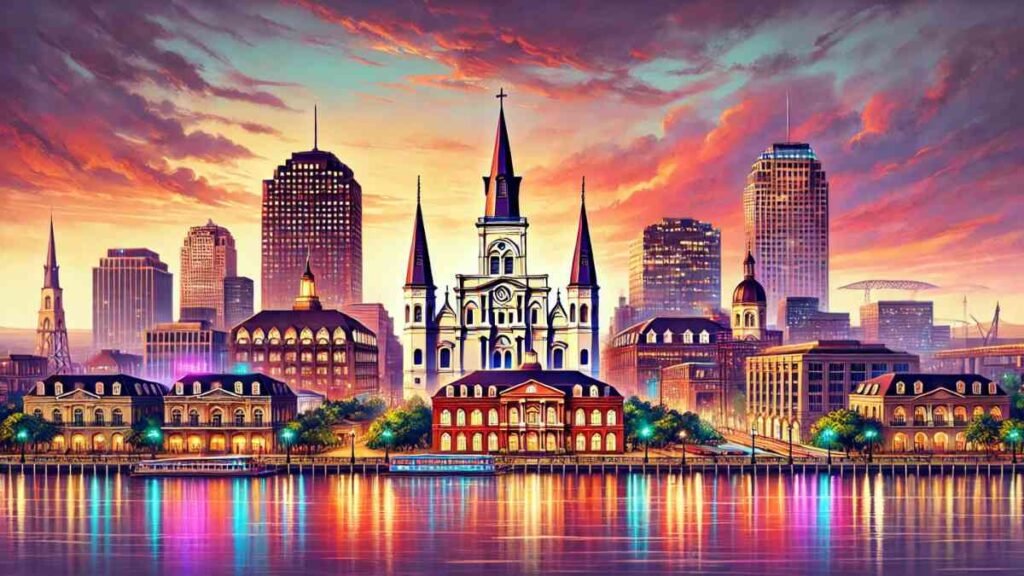The New Orleans Skyline is an iconic symbol of the city’s unique blend of history, culture, and modernity. With towering skyscrapers and historical landmarks, the skyline paints a picture of a city that thrives on its diverse architecture. As the sun sets over the Mississippi River, the skyline transforms into a glowing spectacle, reflecting the vibrant life and rich heritage of New Orleans.
Introduction
New Orleans Skyline offers a captivating view of a city that is as diverse as it is historic. From the charming streets of the French Quarter to the towering skyscrapers in the business district, New Orleans’ skyline tells a story of its evolution. The city’s unique architecture, with influences from French, Spanish, and Creole styles, blends seamlessly with modern high-rises, creating a skyline like no other. Whether you’re standing by the Mississippi River or gazing from a rooftop bar, the New Orleans skyline is a sight to behold.
History and Evolution of the New Orleans Skyline
New Orleans has a rich architectural history that dates back to its founding in 1718. The original city was a small French settlement, but over the years, it grew into one of the most important ports in the United States. As the city expanded, so did its architectural styles. The New Orleans Skyline began to take shape in the late 19th century with the construction of some of the city’s first skyscrapers. However, it wasn’t until the mid-20th century that the city saw the rise of taller structures, adding a modern touch to the skyline. Despite the newer developments, New Orleans has managed to preserve its historical charm, particularly in areas like the French Quarter, where buildings date back centuries.
Iconic Landmarks that Define the New Orleans Skyline
Several landmarks contribute to the distinct character of the New Orleans Skyline. These include both historical structures and modern buildings that together reflect the city’s cultural diversity.
St. Louis Cathedral
One of the most famous landmarks in the city is St. Louis Cathedral, located in Jackson Square. The Cathedral’s three spires are a defining feature of the skyline and represent the rich religious history of New Orleans. Built in 1789, it is the oldest cathedral in continuous use in the United States.
One Shell Square
Standing at 697 feet, One Shell Square is the tallest building in New Orleans. Completed in 1972, this modern skyscraper is a symbol of the city’s economic growth and development. It represents a shift in the skyline from historical architecture to contemporary design.
Hancock Whitney Center
Another key component of the New Orleans Skyline is the Hancock Whitney Center, which is the second tallest building in the city. At 697 feet, this structure offers a stark contrast to the older, more traditional buildings, contributing to the skyline’s dynamic appearance.
The Crescent City Connection
While not a building, the Crescent City Connection bridges, which span the Mississippi River, are a prominent feature of the skyline. These bridges, particularly at sunset, create an unforgettable image as they connect the east and west banks of the city.
The Skyline at Night
As day turns to night, the New Orleans Skyline undergoes a magical transformation. The city lights up, with skyscrapers illuminated against the backdrop of the night sky. Reflections of these lights on the Mississippi River create a mirror-like effect, enhancing the beauty of the skyline. Landmarks like the Mercedes-Benz Superdome and the Smoothie King Center also contribute to the nighttime skyline, particularly during major events such as Mardi Gras or the New Orleans Jazz & Heritage Festival.
Viewing Points for the Best Views of the Skyline
New Orleans offers several vantage points to take in the beauty of its skyline.
Mississippi Riverfront
One of the most popular spots to view the skyline is along the Mississippi Riverfront. Whether you’re walking through Woldenberg Park or taking a cruise on a steamboat, the river offers stunning views of both the old and new architecture that defines the city.
Algiers Point
For those looking to capture the full grandeur of the New Orleans Skyline, Algiers Point provides one of the best views in the city. Located across the river, this neighborhood offers a panoramic view of the skyline, especially at sunset.
Rooftop Bars
Several rooftop bars around the city provide excellent views of the skyline. Locations such as Hot Tin and The Rooftop at the Catahoula Hotel not only offer great drinks but also a breathtaking perspective of the skyline, especially as the city lights up at night.
How the Skyline Reflects the Spirit of New Orleans
The New Orleans Skyline is more than just a collection of buildings; it’s a reflection of the city’s spirit. The mix of old-world charm and modern innovation speaks to the city’s resilience and ability to adapt while staying true to its roots. From the historical landmarks that remind us of the city’s past to the modern skyscrapers that represent its future, the skyline is a symbol of New Orleans’ unique identity.
Future Developments and Their Impact on the Skyline
While New Orleans is known for preserving its historical architecture, the city is also looking toward the future. Several new developments are in the works, which will further enhance the skyline. Projects like the redevelopment of the World Trade Center into a Four Seasons Hotel and new high-rise residential buildings show that the skyline will continue to evolve. However, city planners are committed to ensuring that any new additions complement the existing architecture and preserve the city’s unique character.
Conclusion
New Orleans Skyline is a stunning representation of the city’s rich history, cultural diversity, and modern growth. Whether you’re a resident or a visitor, the skyline is a reminder of what makes New Orleans special. With its blend of old and new, it stands as a testament to the city’s resilience and enduring charm. As you gaze upon the skyline, you’re not just looking at buildings; you’re seeing the heart and soul of New Orleans.
For More Visit, MirrorMagazine.co.uk


